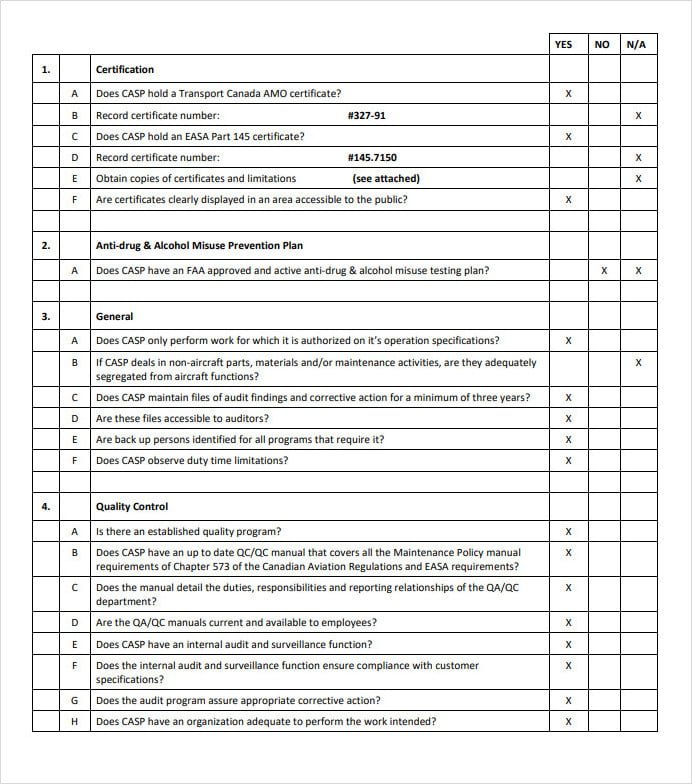Maintaining high standards of quality and compliance is paramount to success in business operations. Conducting vendor audits is crucial to ensuring these standards are met. These audits play a vital role in evaluating the performance and adherence of suppliers and vendors to set criteria.
Businesses often use printable vendor audit checklist templates to streamline this process and enhance its effectiveness. These templates serve as structured tools that guide organizations in assessing their vendors systematically. By customizing these checklists to align with specific business requirements, companies can simplify the audit process and enhance their vendor management practices.

What is a Vendor Audit Checklist?
A Vendor Audit Checklist is a tool utilized by businesses to assess and ensure that their suppliers and vendors are meeting specific standards and requirements. It serves as a comprehensive list of items to evaluate when conducting vendor audits, helping to maintain quality control, mitigate risks, and uphold compliance. By defining criteria, assigning weights, and customizing the checklist, businesses can effectively monitor vendor performance and identify areas for improvement.



Benefits of Vendor Audit Checklists
- Standardized Evaluation: Vendor audit checklists provide a standardized approach to evaluating vendors, ensuring consistency and efficiency in the assessment process.
- Risk Identification: These checklists help in identifying potential risks associated with vendors, allowing businesses to take proactive measures to mitigate these risks.
- Efficiency: By using vendor audit checklists, companies can save time and increase efficiency in evaluating vendors and ensuring compliance with regulations.
- Improvement Opportunities: A well-designed checklist can highlight areas for improvement, enabling businesses to enhance their vendor management processes.
- Reputation Protection: Working with safe and reliable vendors through audit checklists can protect a company’s reputation and reduce the risk of legal or financial penalties.

Key Components of a Vendor Audit Checklist
When creating a comprehensive checklist, it is important to include the following key components:
- Data Security and Privacy: Assess the vendor’s measures to protect sensitive information and ensure compliance with data privacy regulations.
- Financial Stability: Evaluate the vendor’s financial health and stability to mitigate risks associated with potential bankruptcy or financial instability.
- Contract Compliance: Review vendor contracts to ensure adherence to agreed-upon terms, pricing, and service level agreements.
- Product or Service Quality: Examine the quality of products or services provided by the vendor to guarantee they meet the required standards and specifications.


How to Create a Vendor Audit Checklist
1. Define the Scope of the Checklist
When creating a vendor audit checklist, the first step is to clearly define the scope of the checklist. This involves determining the specific areas and aspects of vendor performance that will be evaluated during the audit process. By outlining the scope upfront, you can ensure that the checklist focuses on the most critical factors relevant to your business’s vendor management process.
2. Identify the Audit Criteria
Once the scope is defined, the next step is to identify the audit criteria that will be used to assess vendor performance. These criteria should be aligned with your business’s quality standards and compliance requirements. By clearly outlining the audit criteria, you can ensure that the evaluation process is thorough and objective.
3. Customize the Checklist
Customizing the vendor audit checklist is essential to tailor it to your business’s specific needs. Reviewing the audit criteria and making any necessary additions or removals ensures that the checklist is relevant and comprehensive. Organizing the checklist items in a logical order and making them easy to read and understand enhances its effectiveness in evaluating vendor performance.
4. Assign Weights and Scoring Criteria
Assigning weights and scoring criteria to the checklist items helps prioritize vendor performance factors based on their importance. By assigning weights, you can emphasize critical areas that require closer attention during the audit process. Establishing scoring criteria enables a standardized evaluation method that provides a clear assessment of vendor performance.
5. Follow Up and Measurement
After conducting the vendor audit using the checklist, it is crucial to follow up on any identified issues and track vendor performance over time. Implementing a system for measurement and continuous improvement based on audit findings ensures that vendors maintain compliance and quality standards. Regular follow-ups help address any deficiencies and drive vendor performance enhancement.





Final Thoughts
Utilizing our printable vendor audit checklist template is a strategic approach for businesses to ensure the quality and compliance of their vendors. By customizing the checklist to meet specific organizational needs, businesses can streamline the audit process and identify areas for improvement effectively. With the ability to define the scope, identify criteria, assign weights, and conduct follow-ups, businesses can maintain consistency and compliance in their operations.
The use of a vendor audit checklist template is a valuable tool in enhancing vendor management processes and mitigating risks, contributing to the overall success and efficiency of the business.